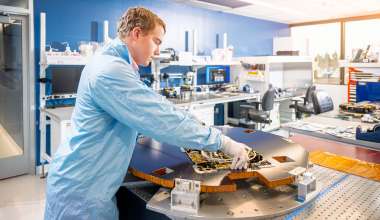The modern space domain is rapidly evolving into an increasingly complex and interconnected environment, with a growing number of emerging players and new technological advancements accelerating the pace of a shifting landscape.
Solving the hardest problems in space now requires a higher level of coordination and collaboration than ever before. The Aerospace Corporation is working across the space enterprise, partnering with national space agencies to identify end-to-end mission needs and to deliver innovative and integrated solutions at the speed of relevance.
“Aerospace is uniquely positioned to increase up-front, cross-customer engagement to achieve mission success from an enterprise perspective. We are working with and across diverse customers and mission areas to advance our nation’s capabilities to lead in space,” said Mark Silverman, Chief Engineer of Aerospace. “The goal is to develop integrated perspectives and solutions leveraging our unique role as the nation's trusted partner for the space enterprise.”
As the trusted partner for space, Aerospace looks to deepen its impact by harnessing the unparalleled breadth and depth of its technical expertise, convening strategic engagement and alignment across National Security, Civil and the rapidly emerging Commercial space while driving the maturation of enabling capabilities, such as digital engineering, cyber, artificial intelligence and rapid prototyping.
Moving Farther, Faster, Together
The modern space enterprise is evolving toward one that is distributed, interoperable, and fully integrated with digital capabilities. Aerospace is supporting its customers in bridging connections across diverse stakeholders that drive the alignment of overlapping needs, efforts and resources to advance shared solutions.
A primary example where integrated operations could create exponential value is in data. The volume of accessible data has expanded beyond the point of human comprehension. Furthermore, different end-users have different needs, and agencies have their own methods of acquiring, storing and using data. However, in order for decisionmakers to rapidly extract actionable intelligence in a real-world scenario across multiple domains, information must be able to be integrated and automated to support next-generation capabilities.
Aerospace continues to support National Security Space in bringing together multiple agencies as well as commercial partners to advance this effort for the warfighter, human spaceflight, and science-related missions.
Leveraging New Opportunities of Modern Space
Due in large part to advances in the commercial sector, the barriers of access to orbit have never been lower. However, reaching the Moon, Mars and beyond while establishing the necessary infrastructure to operate effectively will require a level of effort and resources that no single agency can provide on its own.
However, collaboration and coordination across government agencies could create meaningful opportunities to leverage economies of scale as well as more cost-effective commercial capabilities that optimize value of investments in the national interest.
As an example, in the area of cislunar space, Aerospace is broadly engaged across multiple dimensions of the national strategy in support of Civil and National Security Space customers. Aerospace’s experts are well positioned to promote cross-agency and broader partnerships that advance integrated approaches that enable the space enterprise to achieve more by working together.
Fostering an Integrated Space Enterprise
Aerospace is dedicated to delivering mission success at the enterprise level, supporting its government customers with continuous engagement and a unique perspective that spans across a broad range of mission areas. As the space domain continues to evolve, navigating this changing playing field of new and diverse players will require thinking bigger and adapting the understanding of what “success” really means.
“Aerospace stands ready with its customers and partners to advance the integrated perspectives required to achieve end-to-end mission success,” Silverman said. “With our deep technical expertise and broad reach across the space enterprise, it is a responsibility we embrace.”








